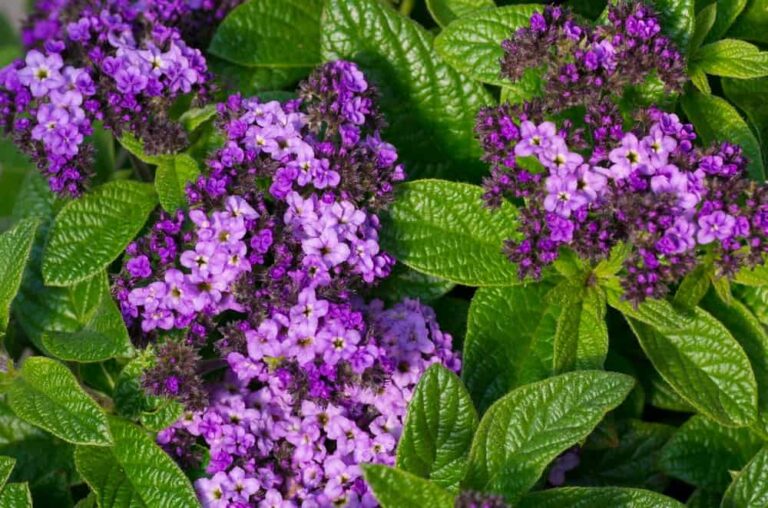Heliotrope (Heliotropium) is a fragrant, bushy plant native to the beautiful lands of Peru, South America. It is commonly grown for its clusters of small, brightly colored flowers that bloom from summer to fall and emit a sweet, vanilla-like fragrance. Its vibrant flowers can be violet, blue, purple, white or pink, and are produced in dense clusters on tall spikes. Heliotrope is also a pretty easy-to-grow plant that is well-suited for container gardens, borders, or as a bedding plant. It requires full sun or light shade and well-drained soil.
Most popular Heliotrope varieties:
- Heliotrope Marine
- Dwarf Marine
- European Heliotrope
- Indian Heliotrope
Care
As Heliotropes are native to the tropical regions of Peru, they require lots of sunlight and moist soil. Other than that, we would say it is a low-maintenance plant. If you are considering growing one, here are the key things you should pay attention to:
- Soil: Heliotropes grow best in soil with good moisture retention, rich in organic matter, and with a pH between 6.6 to 7.3. They require well-draining soil to prevent soggy conditions, but heavy clay soils should be avoided.
- Water: These beautiful plants need consistent watering to grow well. Maintain evenly moist soil without waterlogging, and prevent drying out. Container-grown heliotropes need more frequent watering due to faster water absorption.
- Light: Heliotrope plants need full sun, meaning at least 6 hours of direct sunlight per day. Pick a spot where bright morning sunlight can reach them.
- Temperature: Heliotropes don’t really like hot or humid weather and are also very sensitive to frost damage. The ideal temperature for them is between 70-75 degrees F.
Give it a read

Propagation
Just like propagating Dahlias, growing Heliotropes is not very hard, so if you are a rookie gardener, you are in luck with these beautiful plants. Just get some seeds, and follow these instructions:
- Plant heliotropes in well-draining, rich soil with a slightly acidic to neutral pH (6.6 to 7.3).
- Make sure the soil is consistently moist, but not waterlogged, especially during hot and dry periods.
- Provide full sun to partial shade and protect the plant from strong winds.
- Prune the plant regularly to encourage bushier growth and promote more blooms.
Pruning
As autumn approaches, gentle pruning can be performed before the plants go into their winter dormancy. To ensure your flowers continue to flourish and produce stunning blooms, it’s important to nurture their growth by removing faded flowers and plant debris. If you’re working with pre-cultivated young plants, it’s recommended to regularly pinch off the tips of the shoots. This simple practice encourages the development of side branches, resulting in fuller and more compact plants that don’t shoot up too rapidly in height.
Common Pests
Frequently Asked Questions
Because it contains pyrrolizidine alkaloids, a toxin also found in Paterson’s curse. These alkaloids can cause damage to the liver.
Where does heliotrope grow best?
Heliotrope grows best in moist, well-drained soil with a slightly acidic to neutral pH (6.6 to 7.3) in a location that receives full sun to partial shade.
What does heliotrope smell like?
Heliotrope has a sweet, vanilla-like scent. Many brands use these plants for their perfumes. Its scent can also evoke nuances of lilac.
What temperature can heliotrope tolerate?
The Heliotrope plant can tolerate temperatures between 60-75°F (15-24°C). It can be damaged or killed by temperatures below 50°F (10°C).
